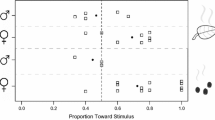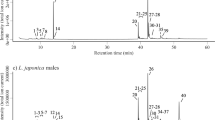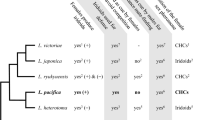Abstract
Carnivorous animals put selection pressure on their herbivorous preys, leading to the development of defensive traits in prey species and counter defensive traits in carnivores—an evolutionary arms race for survival. For instance, larvae of the moth Heliothis virescens use defensive oral secretions to deter attacking parasitic wasps (parasitoids). However, it is not clear whether parasitoids also use the same secretion for host location. If carnivores follow the herbivore model, evolution should favor specialist over generalist parasitoid species in their ability to manipulate host defensive chemicals. To test this prediction, Microplitis croceipes and Cotesia marginiventris, both larval endoparasitoids of H. virescens, were used as a study system. Microplitis croceipes is relatively specialized on Heliothis/Helicoverpa species while C. marginiventris is a generalist parasitoid on several noctuid host species. Innate behavioral responses of parasitoids to host defensive secretion were tested in Petri dish arena and Y-tube olfactometer bioassays. Heliothis virescens defensive secretion was manually applied to a spot in a sector (secretion zone) of the arena. Tracking data suggests that both parasitoid species are likely to locate the secretion spot once they enter the secretion zone. Comparing the two species, however, M. croceipes (specialist) spent significantly more time in the secretion zone and spot than C. marginiventris (generalist). In Y-tube olfactometer bioassays, the secretion elicited a strong attraction in M. croceipes but not in C. marginiventris, supporting our prediction. We discussed chemical-mediated counter defense in natural enemies of pest insects and the significance of the results to parasitoid-host coevolution.






Similar content being viewed by others
References
Ademokoya B, Balusu R, Morawo T, Fadamiro H (2017) Attraction of Paratelenomus saccharalis (Hymenoptera: Platygastridae), an egg parasitoid of Megacopta cribraria (Hemiptera: Plataspidae), to host-associated olfactory cues. J Entomol Sci 52:323–331. https://doi.org/10.18474/JES17-01PT.1
Afsheen S, Xia W, Ran L et al (2008) Differential attraction of parasitoids in relation to specificity of kairomones from herbivores and their by-products. Insect Sci 15:381–397. https://doi.org/10.1111/j.1744-7917.2008.00225.x
Agrawal AA, Petschenka G, Bingham RA et al (2012) Toxic cardenolides: chemical ecology and coevolution of specialized plant–herbivore interactions. New Phytol 194:28–45. https://doi.org/10.1111/j.1469-8137.2011.04049.x
Azandémè-Hounmalon GY, Torto B, Fiaboe KKM et al (2016) Visual, vibratory, and olfactory cues affect interactions between the red spider mite Tetranychus evansi and its predator Phytoseiulus longipes. J Pest Sci 89:137–152. https://doi.org/10.1007/s10340-015-0682-y
Bernays EA (1998) Evolution of feeding behavior in insect herbivores. Bioscience 48:35–44. https://doi.org/10.2307/1313226
Beyaert I, Wäschke N, Scholz A et al (2010) Relevance of resource-indicating key volatiles and habitat odour for insect orientation. Anim Behav 79:1077–1086. https://doi.org/10.1016/j.anbehav.2010.02.001
Chen L, Fadamiro HY (2018) Pseudacteon phorid flies: host specificity and impacts on Solenopsis fire ants. Annu Rev Entomol 63:47–67. https://doi.org/10.1146/annurev-ento-020117-043049-043049
Dawkins R, Krebs JR (1979) Arms races between and within species. Proc R Soc B Biol Sci 205:489–511. https://doi.org/10.1098/rspb.1979.0081
Delphia CM, Mescher MC, Felton GW, Moraes CM, De (2006) The role of insect-derived cues in eliciting indirect plant defenses in tobacco, Nicotiana tabacum. Plant Signal Behav 1:243–250
Despres L, David J-P, Gallet C (2007) The evolutionary ecology of insect resistance to plant chemicals. Trends Ecol Evol 22:298–307. https://doi.org/10.1016/j.tree.2007.02.010
Desurmont GA, Köhler A, Maag D et al (2017) The spitting image of plant defenses: effects of plant secondary chemistry on the efficacy of caterpillar regurgitant as an anti-predator defense. Ecol Evol 7:6304–6313. https://doi.org/10.1002/ece3.3174
Dietrick EJ, van der Bosch R (1957) Insectary propagation of the squash bug and its parasite Trichopoda pennipes Fabr. J Econ Entomol 50:627–629
Eberhard WG (1977) Aggressive chemical mimicry by a bolas spider. Science 198:1173–1175. https://doi.org/10.1126/science.198.4322.1173
Engler-Chaouat HS, Gilbert LE (2007) De novo synthesis vs. sequestration: negatively correlated metabolic traits and the evolution of host plant specialization in cyanogenic butterflies. J Chem Ecol 33:25–42. https://doi.org/10.1007/s10886-006-9207-8
Fry JD (1996) The evolution of host specialization: are trade-offs overrated? Am Nat 148:S84–S107
Fürstenberg-Hägg J, Zagrobelny M, Bak S (2013) Plant defense against insect herbivores. Int J Mol Sci doi. https://doi.org/10.3390/ijms140510242
Glendinning JI (2007) How do predators cope with chemically defended foods? Biol Bull 213:252–266. https://doi.org/10.2307/25066643
Goff AM, Nault LR (1974) Aphid cornicle secretions ineffective against attack by parasitoid wasps. Environ Entomol 3:565–566. https://doi.org/10.1093/ee/3.3.565
Gross P (1993) Insect behavioral and morphological defenses against parasitoids. Annu Rev Entomol 38:251–274. https://doi.org/10.1146/annurev.ento.38.1.251
Hays DB, Vinson SB (1971) Acceptance of Heliothis virescens (Lepidoptera: Noctuidae) as a host by the parasite Cardiochiles nigriceps (Hymenoptera: Braconidae). Anim Behav 19:344–352. https://doi.org/10.1016/S0003-3472(71)80015-5
Ivie GW, Bull DL, Beier RC, Pryor NW, Oertli EH (1983) Metabolic detoxication: mechanism of insect resistance to plant psoralens. Science 221:374–376. https://doi.org/10.1126/science.221.4608.374
Jeffries MJ, Lawton JH (1984) Enemy free space and the structure of ecological communities. Biol J Lin Soc 23:269–286. https://doi.org/10.1111/j.1095-8312.1984.tb00145.x
Kazana E, Pope TW, Tibbles L et al (2007) The cabbage aphid: a walking mustard oil bomb. Proc R Soc B Biol Sci 274:2271–2277. https://doi.org/10.1098/rspb.2007.0237
Köpf A, Rank NE, Roininen H, Tahvanainen J (1997) Defensive larval secretions of leaf beetles attract a specialist predator Parasyrphus nigritarsis. Ecol Entomol 22:176–183. https://doi.org/10.1046/j.1365-2311.1997.t01-1-00061.x
Laumann RA, Aquino MFS, Moraes MCB, Pareja M, Borges M (2009) Response of the egg parasitoids Trissolcus basalis and Telenomus podisi to compounds from defensive secretions of stink bugs. J Chem Ecol 35:8–19. https://doi.org/10.1007/s10886-008-9578-0
Lewis WJ, Burton RL (1970) Rearing Microplitis croceipes in the laboratory with Heliothis zea as host. J Econ Entomol 63:656–658. https://doi.org/10.1093/jee/63.2.656
Mattiacci L, Vinson SB, Williams HJ, Aldrich JR, Bin F (1993) A long-range attractant kairomone for egg parasitoid Trissolcus basalis, isolated from defensive secretion of its host, Nezara viridula. J Chem Ecol 19:1167–1181. https://doi.org/10.1007/BF00987378
Mithöfer A, Boland W (2012) Plant defense against herbivores: chemical aspects. Annu Rev Plant Biol 63:431–450. https://doi.org/10.1146/annurev-arplant-042110-103854
Morawo T, Fadamiro H (2016) Identification of key plant-associated volatiles emitted by Heliothis virescens larvae that attract the parasitoid, Microplitis croceipes: implications for parasitoid perception of odor blends. J Chem Ecol 42:1112–1121. https://doi.org/10.1007/s10886-016-0779-7
Ngumbi E, Chen L, Fadamiro H (2010) Electroantennogram (EAG) responses of Microplitis croceipes and Cotesia marginiventris and their lepidopteran hosts to a wide array of odor stimuli: correlation between EAG response and degree of host specificity? J Insect Physiol 56:1260–1268. https://doi.org/10.1016/j.jinsphys.2010.03.032
Opitz SEW, Muller C (2009) Plant chemistry and insect sequestration. Chemoecology 19:117–154. https://doi.org/10.1007/s00049-009-0018-6
Rana JS, Dixon AFG, Jarošík V (2002) Costs and benefits of prey specialization in a generalist insect predator. J Anim Ecol 71:15–22. https://doi.org/10.1046/j.0021-8790.2001.00574.x
Rotheray GE (1981) Host searching and oviposition behavior of some parasitoids of aphidophagous Syrphidae. Ecol Entomol 6:79–87. https://doi.org/10.1111/j.1365-2311.1981.tb00974.x
Scharff N, Hormiga G (2012) First evidence of aggressive chemical mimicry in the malagasy orb weaving spider Exechocentrus lancearius Simon, 1889 (Arachnida: Araneae: Araneidae) and description of a second species in the genus. Arthropod Syst Phylogeny 70:107–118
Sloggett JJ (2008) Weighty matters: body size, diet and specialization in aphidophagous ladybird beetles (Coleoptera: Coccinellidae). Eur J Entomol 105:381–389. https://doi.org/10.14411/eje.2008.048
Stamp N (2001) Enemy-free space via host plant chemistry and dispersion: assessing the influence of tri-trophic interactions. Oecologia 128:153–163. https://doi.org/10.1007/s004420100679
Tillman PG, Laster ML (1995) Parasitization of Heliothis virescens and H. virescens–H. subflexa Backcross (Lepidoptera: Noctuidae) by Microplitis croceipes (Hymenoptera: Braconidae). Biol Control 24:409–411. https://doi.org/10.1093/ee/24.2.409
Ulrich KR, Kramer M, Feldlaufer MF (2016) Ability of bed bug (Hemiptera: Cimicidae) defensive secretions (E)-2-hexenal and (E)-2-octenal to attract adults of the common bed bug Cimex lectularius. Physiol Entomol 41:103–110. https://doi.org/10.1111/phen.12129
Vet LEM, Dicke M (1992) Ecology of infochemical use by natural enemies in a tritrophic context. Annu Rev Entomol 37:141–172. https://doi.org/10.1146/annurev.ento.37.1.141
Vinson SB, Jones RL, Sonnet PE, Bierl BA, Beroza M (1975) Isolation, identification and synthesis of host-seeking stimulants for Cardiochiles nigriceps, a parasitoid of tobacco budworm. Entomol Exp Appl 18:443–450. https://doi.org/10.1111/j.1570-7458.1975.tb00421.x
Winde I, Wittstock U (2011) Insect herbivore counteradaptations to the plant glucosinolate–myrosinase system. Phytochemistry 72:1566–1575. https://doi.org/10.1016/j.phytochem.2011.01.016
Witte L, Ehmke A, Hartmann T (1990) Interspecific flow of pyrrolizidine alkaloids. Naturwissenschaften 77:540–543. https://doi.org/10.1007/BF01139268
Wu Y, Wang H, Wang H, Feng J (2018) Arms race of temporal partitioning between carnivorous and herbivorous mammals. Sci Rep 8:1–9. https://doi.org/10.1038/s41598-018-20098-6
Zvereva EL, Rank NE (2004) Fly parasitoid Megaselia opacicornis uses defensive secretions of the leaf beetle Chrysomela lapponica to locate its host. Oecologia 140:516–522. https://doi.org/10.1007/s00442-004-1602-7
Zvereva EL, Zverev V, Kruglova OY, Kozlov MV (2017) Strategies of chemical anti-predator defences in leaf beetles: is sequestration of plant toxins less costly than de novo synthesis? Oecologia 183:93–106. https://doi.org/10.1007/s00442-016-3743-x
Acknowledgements
We thank Jean Linn and Basu Kafle for rearing the insects used for this study. This study was supported by Auburn University and the Alabama Agricultural Experiment Station.
Author information
Authors and Affiliations
Corresponding author
Additional information
Communicated by Marko Rohlfs.
Electronic supplementary material
Below is the link to the electronic supplementary material.
Supplementary material 2 (MP4 13846 KB)

Rights and permissions
About this article
Cite this article
Morawo, T., Fadamiro, H. Chemical-mediated counter defense: attraction of two parasitoid species to the defensive secretion of host larvae. Chemoecology 28, 153–162 (2018). https://doi.org/10.1007/s00049-018-0268-2
Received:
Accepted:
Published:
Issue Date:
DOI: https://doi.org/10.1007/s00049-018-0268-2




